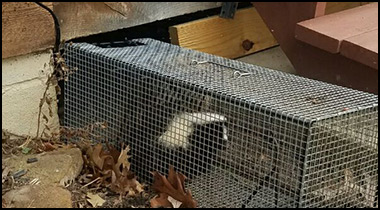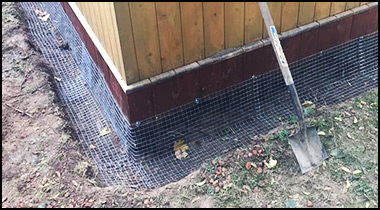San Antonio Skunk Removal Resources
Skunk Rehabber - Wildlife Rescue & Rehabilitation, Inc: (210) 257-8823
Free Bexar County Animal Services: 210-207-6650
Humane Wildlife Trappers of San Antonio: 210-672-4385
If you need skunk control in San Antonio, you have a few options. First, you can attempt to solve the skunk problem yourself by reading our do-it-yourself guide. If you need outside help, you can also call Bexar County Animal Services to see if they have any free resources or help for you - however, they primarily deal with dog and cat concerns. You can also call a local San Antonio wildlife rehabber, as they are typically a great resource for advice that is in the best welfare of the animal. If as a last resort you must hire a professional company, we recommend Humane Wildlife Trappers of San Antonio at 210-672-4385. To learn more about them or check their skunk removal prices, visit sanantoniopestanimal.com.

San Antonio Skunk Trapping and Removal

Preventative Repairs & Exclusion

San Antonio Skunk Removal From Structures
In many cases, preventative measures can solve your San Antonio skunk problem - keep garbage secured, pet food indoors, and most of all when it comes to skunks, secure the perimeter of your shed, porch, deck, or house with a barrier - lattice or steel mesh is good, and it keeps Texas skunks from going under the structure. If trapping and removal of the skunk is the only option you have, please do so with the help of a local agency or professional company who knows how to do it humanely and legally. Browse the resources of this site for more educational information.
Frequently Asked Questions:
Prevention: How to Keep Skunks Away
What to do with a skunk after I catch it?
Is it legal for me to trap a skunk?
How to remove skunk odor
Is a skunk active during the daytime rabid?
What does skunk feces look like?
San Antonio Skunk Control Information: Why do Skunks Have White Stripes?
Not all skunks have white stripes. The prominence of striped or spotted skunks can be found located in various areas of the earth. Skunks do not have stripes, spots, and coarser coats or come in various sizes as a way of making locality fashion statements.
Only recently learned for instance the striped skunk stripes are a part of the warning devices that this particular skunk has. Other than stomp or hiss the stripe also is a method of directing eyes to the anal glands. In this manner the skunk is more or less assured that when it does spray it will be in the most sensitive area of the predator, the eyes.
Studies however have proven that most spraying mammals have stripes for the same reasons as striped skunks. While over time other animals may demonstrate changes in their stripes in some shape or form. The striped skunk has not undergone such evolutionary changes.
Many animals will have stripes or certain colorations for camouflage. However, the need for camouflage for the skunk is only a working theory. That can be supported by the lack of aggressiveness and easily frightened personality.
While we may think that skunks primarily spend their time in the woods or in the yard. By the number of dead skunks found along the highways it is easy to assume they are more comfortable along the side of the road. In studying this theory it has been found that the colorations of the striped skunk does indeed blend in with the white stripes on a highway.
In this manner, the skunk that is neither fast nor agile can best hide from its predator by traveling right down the middle of a highway on the white line. Being a nocturnal animal, this is easy prey for the automobile. With the number of deceased skunks on the road, there are still plenty more skunks to find. The secret to the amount of dead skunks may be based on the fact that the skunks' stripes are sometimes crosswire to the stripes on the highway.
Again this is only a working theory and only a few studies have been done to prove or disprove this theory. With the lack of evolution to these particular mammals it only stands to reason that if there were an evolution, like all manners of evolutions to move with the times. In this case the highways
Remember, for free services you can try (210) 257-8823 or 210-207-6650, but if you need to pay for professional help, check the prices at the sanantoniopestanimal.com website. Or follow our do-it-yourself guide!

